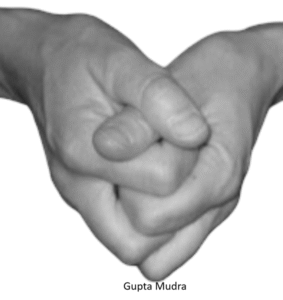Gupta Mudra (Hidden Gesture)
Introduction
Gupta Mudra, also called the Hidden Gesture, is a yogic hand gesture used to internalize energy, enhance concentration, and promote inner calm. This mudra is commonly practiced during meditation and pranayama to encourage mental clarity, spiritual insight, and subtle energy flow.
It is believed to help the practitioner focus inward, balance prana, and cultivate mindfulness.
Meaning
Etymology:
Gupta means hidden or secret in Sanskrit.
Mudra means gesture or seal.
Symbolism:
Represents inner awareness, introspection, and subtle energy control.
Encourages mental focus, self-discipline, and spiritual insight.
Symbolically helps retain and circulate prana within the body.
How to Perform Gupta Mudra
Sit comfortably in a meditation posture (Sukhasana, Padmasana, or Vajrasana) with a straight spine.
Interlace fingers inwards towards palms, cross right thumb over left and hold in front of abdomen.
Close your eyes and focus on deep, slow breathing, visualizing energy being retained and circulated within the body.
Maintain this mudra for 10–20 minutes daily during meditation or pranayama.
Tip: Practicing in a quiet environment enhances mindfulness and internal energy awareness.
Benefits
Enhances mental focus, clarity, and memory.
Promotes inner calm, emotional stability, and mindfulness.
Stimulates subtle energy circulation within the body.
Supports prana retention and balancing of energy channels.
Helps reduce stress, anxiety, and mental fatigue.
Encourages spiritual insight and self-awareness.
Contraindications
Avoid if there is injury, pain, or inflammation in fingers, hands, or wrists.
People with joint limitations or arthritis should practice gently.
Discontinue if discomfort occurs during practice.
Anatomy & Physiology
Involves phalanges, interphalangeal joints, intrinsic hand muscles, and forearm muscles.
Stimulates median and ulnar nerve endings, enhancing sensory perception and cortical activity.
Improves circulation in hands and forearms, indirectly supporting autonomic nervous system regulation.
Promotes relaxation in shoulders, chest, and upper back, facilitating deep breathing and subtle energy flow.
Kinesiology
Isometric contraction of thenar, hypothenar, and interossei muscles maintains finger position.
Minimal engagement of forearm muscles, allowing relaxation while maintaining posture.
Enhances fine motor control, proprioception, and hand awareness.
Supports mind-body integration through intentional hand placement and meditative focus.
Neurology
Activates median and ulnar nerves, stimulating somatosensory and motor cortices.
Promotes parasympathetic nervous system activation, reducing stress and enhancing calmness.
Visualization of energy retention strengthens neural pathways associated with concentration, introspection, and mindfulness.
Duration of Practice
Beginners: 5–10 minutes daily.
Intermediate/Advanced: 15–20 minutes, once or twice daily.
Can be practiced during meditation, pranayama, or energy-balancing routines.
Counter Mudra
Prana Mudra or Gnana Mudra can act as counter mudras to energize and activate subtle energy after inward-focused practice.
Alternating Gupta Mudra with these mudras balances inner awareness with outward energy activation.
Conclusion
Gupta Mudra is a powerful gesture for introspection, mental clarity, and subtle energy balance. Regular practice enhances focus, mindfulness, calmness, and spiritual insight, making it an excellent addition to meditation, pranayama, and yoga therapy practices.
FAQ
Q1: Can Gupta Mudra improve concentration?
A1: Yes, it enhances focus and mental clarity by stimulating subtle energy pathways.
Q2: Can children practice it?
A2: Yes, under supervision and with gentle finger placement.
Q3: Is visualization necessary?
A3: Visualization enhances effects, but mindful hand placement and breathing are sufficient.
Q4: Can it be combined with other mudras?
A4: Yes, especially with pranayama or meditation mudras for energy balancing.
References
Swami Satyananda Saraswati, Mudras for Healing and Transformation, Bihar Yoga Publications, 2012.
Dr. Harish Johari, Mudra: The Gateway to Health, Inner Traditions, 1994.
B.K.S. Iyengar, Light on Yoga, HarperCollins, 2005.
Yoga Journal, Mudras for Meditation, Focus, and Energy Balance, 2018.
Hatha Yoga Pradipika and yogic texts on subtle energy, prana flow, and meditation practices.
